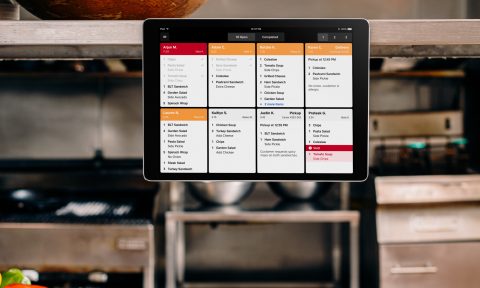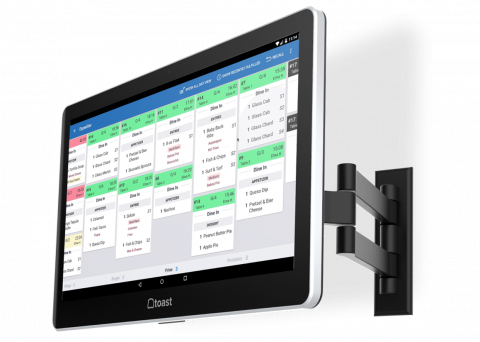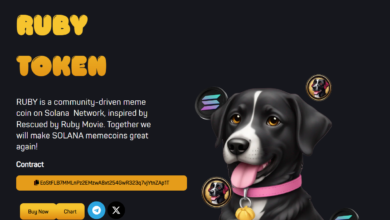What Is a KDS? How a Kitchen Display System Can Work for You

A kitchen show system, or KDS, manages buyer orders for eating places on a display screen within the kitchen, changing the necessity for printing order tickets. For many years, the one place you had been prone to see a KDS was a quick meals restaurant. However the techniques have lately seen wider adoption because the expertise behind them has develop into cheaper and simpler to implement.
Earlier than kitchen show techniques
The legacy methodology of managing orders seems like this:
-
An order is positioned. When a server inputs a buyer order right into a point-of-sale system, a small receipt-like ticket prints within the kitchen.
-
Tickets are manually organized. As these tickets seem, kitchen workers may lay them on a counter or safe them to a ticket rail above the grill or prep space.
-
Tickets are manually prioritized. Ideally, tickets are organized in order that the assorted orders from a single desk are accomplished directly and delivered on time.
-
Workers could make notifications and adjustments manually. If order updates or modifications are available later, a brand new ticket is perhaps printed to switch the outdated one, or a supervisor, prepare dinner or chef may write up to date info on the ticket. A white board on the wall may show handwritten info like dishes or elements which have run out.
All of that is changed with a KDS.
A KDS sometimes is a flat-screen monitor, usually mounted to a wall at eye stage within the kitchen. Some kitchens have screens at a number of places, although one is adequate for a lot of. The screens normally have contact screens, although some have a separate enter machine, like a keypad. You may encounter a KDS that runs on an ordinary pill, like an iPad, whereas others are designed and constructed particularly for KDS use.
Usually talking, a contemporary KDS has most of the following capabilities:
-
An order is positioned. When a server inputs a buyer order, it’s routed to a digital show within the kitchen.
-
It’s routed to the best place robotically. If the restaurant has a number of KDS screens, the assorted elements of an order might be preprogrammed to be routed to the suitable place (the grill or the fry station, for instance).
-
Workers can entry particulars simply. Recipe particulars and photographs can seem on the display screen.
-
Dishes are robotically prioritized. Primarily based on anticipated prep time, the system can correctly tempo the beginning time for every dish on an order. If the prompts are adopted, the assorted dishes on an order shall be accomplished on the proper time.
-
Workers could make notifications or adjustments robotically. Workers obtain an alert if an order adjustments or is not on time. Workers, and in some instances clients, obtain an alert when meals is prepared.
-
You possibly can analyze the information. The system collects and compiles knowledge, like common prepare dinner time, into experiences.
The advantages {that a} KDS presents might be boiled down to 2 varieties of capabilities: People who substitute and enhance upon current paper-based processes and those who supply one thing fully new.
-
The whole lot’s digital. No extra misplaced, torn or burned tickets.
-
It centralizes info. Having a single supply of data everybody can entry might help keep away from miscommunications, bypassing the necessity to depend on verbal or handwritten updates to orders.
-
Tough duties are automated. Complicated duties like dish sequencing and timing tickets — issues as soon as finished by hand — are actually accomplished robotically, immediately and precisely.
-
It could possibly make evaluation simpler. A KDS may also use the information generated over time and create experiences. These experiences might help your small business develop into extra environment friendly. For instance, you’ll have the ability to see if it’s taking longer than anticipated to get sure dishes out of the kitchen, or if sure days or instances see drops in efficiency.
Kitchen show techniques aren’t area of interest merchandise that profit solely particular varieties of eating places, in keeping with Ron Blum, an affiliate professor at Johnson & Wales College who focuses on hospitality expertise. “They’re right here to remain,” he says. “You’re going to see increasingly more acceptance of them.”
Blum says that utilizing a KDS is a good suggestion for many eating places. Even locations with small kitchens, like a espresso store or cafe with a small menu, may gain advantage. The financial savings in paper alone can usually result in critical financial savings. In different phrases, the query to ask isn’t whether or not a KDS would profit your restaurant: Assume it might, and start thinking about how you could possibly implement one most successfully.
Along with bringing extra effectivity to a kitchen, one oblique advantage of utilizing a KDS is the flexibility to retailer information which may at present exist with just a few longer-tenured workers and share it with everybody. In an setting the place turnover is widespread, retaining essential particulars might help shorten the time wanted to coach new workers.
Blum mentioned the downsides — the upfront funding and preliminary studying curve when implementing any new system — are solely momentary.
For anybody contemplating getting began with a KDS, Blum recommended beginning small with the aim of increasing. Arrange a KDS wherever the central hub occurs to be in your kitchen — seemingly the place the printer is now — earlier than including extra places.
When a KDS won’t make sense
Utilizing a KDS can profit many varieties of eating places. Nevertheless it won’t make as a lot sense if:
-
Your KDS choices are restricted by your point-of-sale system. In case you don’t like the alternatives obtainable, you may favor to stay with paper (or have a look at different POS techniques).
-
Your kitchen doesn’t have an excellent place to mount a KDS. As well as, the {hardware} won’t fit your wants; some KDS setups function solely on a contact display screen, which could possibly be tough to make use of in some environments.
-
When you’ve got a small house and a restricted menu, like some meals vans, a KDS won’t be price it.
Tips on how to get began with a KDS
In case you use a more recent, cloud-based POS, like Toast, your alternative of KDS is perhaps restricted to a proprietary possibility supplied by that firm. Inquiries to ask embrace:
-
Is the {hardware} included, or do you provide your personal?
-
Does the corporate provide or suggest mounting {hardware}?
-
What are the prices? Many of those techniques use subscription pricing, however you’ll wish to affirm.
-
What would beginning small appear like, and in what methods may you develop into the system?
-
What varieties of experiences can the KDS generate?
In case you use an older POS system, you’ll wish to examine with the producer to see what choices can be found.
Lightspeed

Picture courtesy of Lightspeed
Worth: $10 per display screen per thirty days plus price of {hardware}.
Overview: Lightspeed’s well-priced KDS aids kitchen workers in coordinating supply, pickup and in-house eating with useful icons. Different kitchen-friendly particulars — like the flexibility to shortly scan wait instances with colour coding on every digital ticket or a breakdown of which dishes see the largest delay — make this an excellent possibility.
Sq.

Picture courtesy of Sq.
-
$20 per thirty days per show plus price of {hardware} if utilizing Sq.’s free Restaurant software program.
-
Free to make use of for those who subscribe to Restaurant Plus ($60 per thirty days) plus price of {hardware}.
Overview: This KDS doesn’t price something additional for those who use Sq. Plus, which is the paid model of its restaurant POS system. In case you use Sq.’s free POS, it should price you $20 per display screen per thirty days, which remains to be an excellent deal. The function listing of this KDS isn’t as deep as some others, however counter service or pickup- and delivery-oriented eating places could discover that the mixture of pricing and Sq.’s simple consumer interface make this an excellent possibility.
Toast

Picture courtesy of Toast
Worth: $25 per thirty days plus one-time price of $499 for {hardware}.
{Hardware} used: Customized machine designed by Toast.
Overview: It prices greater than the others, however Toast presents just a few options the others don’t. The corporate says its custom-built machine is constructed for abuse, withstanding greater temperatures than iPads, for instance. It additionally helps a number of languages and lets the kitchen ping servers (or friends) through textual content or an app when their meals is up.





